What is Lean Six Sigma?
Lean Six Sigma is simply a set of methods and tools to simplify, streamline and optimize every aspect of any business to maximize productivity and profitability. While there are many methods and tools in Lean Six Sigma, a handful of tools, the Magnificent Seven, will solve most of the problems facing businesses today.
What is Lean?
Lean thinking focuses on removing the non-value added (NVA) delay, waste, and rework from your processes. Lean can be used in any industry or business. While it comes from the Toyota Production System, it can be used to streamline and accelerate patient flow in hospitals or transaction processing in computers.
Here's what every customer wants...and the only way to reliably deliver everything As Soon As Possible is to use Lean Six Sigma.

What is Six Sigma?
Six Sigma is an aggressive method for breakthrough improvement in speed, quality and cost. When implemented properly, Six Sigma focuses on results, not training. Instead of measuring errors in percentages, you measure them in parts per million (PPM).
Most newly implemented processes or software applications have error rates of 20-30% (300,000 PPM-2 sigma). When the economy turns down or sales heat up, the costs of fixing these defects can easily put a stranglehold on the company. The dot-coms learned this the hard way in 2000.
Over time, these business processes get to error rates of around 3% (30,000PPM-3.5 sigma), but it's slow, expensive, and takes a long time. Because you can be profitable at this level, most companies fail to go any farther. But failure to "raise the bar" leaves you vulnerable to "quality" competitors. The auto industry learned this from Japanese competition in the 1980s.
What is Lean Six Sigma Simplified?
Most companies spend $15,000 to $40,000 to train a "black belt" in all of the exotic statistical tools necessary to solve all of the possible problems in a manufacturing or service business. But to go from 3 Sigma (30,000 PPM) to 5 Sigma (300 PPM), you don't really need all of the exotic statistical tools, you only need the common science of Lean Six Sigma: a few key tools and laser focus. Have you ever noticed that to maximize your results in any endeavor you don't usually need to know everything, just a few essential elements? The same is true with Lean Six Sigma. With just a few key tools - Control Charts, Pareto Charts, fishbones, and countermeasures - most companies can easily and routinely find ways to save big bucks and add them to the bottom line.
If it costs $10 to fix just one error, then going from 30,000ppm to 300ppm will prevent 29,700 errors and save $297,000. But there are additional costs of fixing an error-lost productivity (another $10), downstream costs ($10-$80), and lost sales from lost productivity and poor quality. In reality, a typical defect or error can cost $50-$100 or more when you add in all of the related costs.
What is the Six Sigma Process?
The new acronym is DMAIC (Define, Measure, Analyze, Improve, Control). For most people this quality jargon is still confusing, and the underlying process and tools are identical to TQM! It's simply a new map to a well established territory. So I created the following simple acronym:
| FISH | Step | Activity | Tools |
| Focus | 1 | Focus with laser-like precision for maximum results with minimum investment | Control Chart Pareto Chart Histogram |
| Improve | 2 | Reduce delay, defects, and costs by 50% in your mission-critical systems (not all of them) | Fishbone Diagram Countermeasures Action Plan |
| Sustain | 3 | Stabilize and sustain the improvement to retain the benefits | Control Charts |
| Honor | 4 |
Recognize, review and refocus efforts on the next set of mission-critical problems |
Learn More...
- Lean for Healthcare and Hospitals
- Lean for Manufacturing
- Lean for Services
- Six Sigma in a Nutshell
- Six Sigma for Healthcare and Hospitals
- Six Sigma for Manufacturing
- Six Sigma for Services
- DMADV Tools for Six Sigma
 Take our FREE Lean Six Sigma Yellow Belt training online.
Take our FREE Lean Six Sigma Yellow Belt training online.
 Take our FREE Lean Six Sigma Yellow Belt training online.
Take our FREE Lean Six Sigma Yellow Belt training online.

